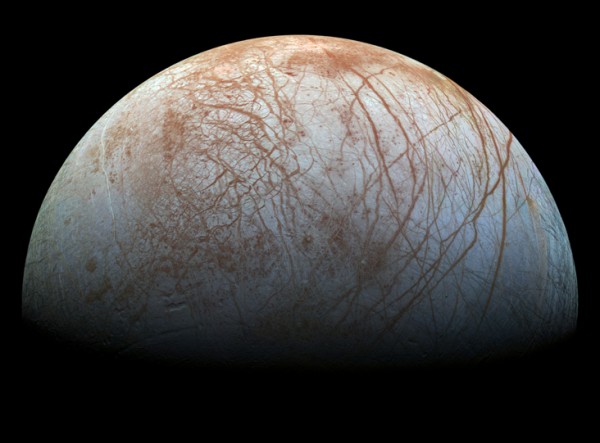Mysterious Streaks on Jupiter's Moon Europa Revealed: Salt Exposed to Radiation
| Ana Verayo | | May 13, 2015 03:20 AM EDT |
(Photo : NASA/JPL-Caltech/SETI Institute) A color view of Europa from Galileo that shows the largest portion of the moon's surface at the highest resolution.
A new NASA experiment is suggesting that a strange dark material that covers some geographical features on Jupiter's moon Europa could be sea salt that has risen from a massive ocean under its icy surface.
The deposits' dark coloring can be attributed to long exposures from intense radiation emanating from Jupiter's magnetic field, according to researchers.
Like Us on Facebook
NASA conducted a number of laboratory experiments that lead to Europa's ocean activity with the mineral rich sea floor, which can provide clues that could support life that are hidden under the frozen surface.
According to Curt Niebur who is an Outer Planets Program scientist at NASA headquarters in Washington, D.C, there are many questions about Europa however the most pivotal one and also the most challenging to answer is if there is life on the satellite. Further research can answer this question and determine if Europa is indeed habitable or not. This answer is the first step whether to explore life under Europa's ocean hidden within its icy shell.
To date, scientists are still exploring the material that has been coating the surface of Europa with streaks of straight and fractured lines along with younger surface features on the moon.
The dark material appears to have spread its presence on the younger features of the moon from the moon's interior but scientists are still stumped as to what is the exact chemical or organic composition of this mysterious material.
NASA then simulated Europa's icy surface with an experiment called "Europa in a can" where it involved near vacuum and extreme cold temperature conditions along with intense radiation found on the surface.
Researchers used samples from material that can create the similar spectra from light reflecting compounds that can also be found on Europa, matching the dark hue on its geographical features.
Samples such as table salt mixed with water were tested in 280 degrees Fahrenheit temperatures and exposed to heavy irradiation for seven hours within the simulated Europa surface environment. The experiment yielded a yellow brown color that closely matched the mysterious dark material on Europa.
According to Kevin Hand who is a planetary scientist at NASA's Jet Propulsion Laboratory, California, this chemical signature of the radiation baked sodium chloride is almost a match to the spacecraft data obtained from Europa's mysterious material.
He also adds that the longer exposure to radiation makes the color darker over time that hints at the age and composition of the material.This study is published in the in the journal, Geophysical Research Letters.
TagsJupiter, Europa, jupiter moon europa, dark mysterious material Europa
©2015 Chinatopix All rights reserved. Do not reproduce without permission
EDITOR'S PICKS
-

Did the Trump administration just announce plans for a trade war with ‘hostile’ China and Russia?
-

US Senate passes Taiwan travel bill slammed by China
-

As Yan Sihong’s family grieves, here are other Chinese students who went missing abroad. Some have never been found
-

Beijing blasts Western critics who ‘smear China’ with the term sharp power
-

China Envoy Seeks to Defuse Tensions With U.S. as a Trade War Brews
-

Singapore's Deputy PM Provides Bitcoin Vote of Confidence Amid China's Blanket Bans
-

China warns investors over risks in overseas virtual currency trading
-

Chinese government most trustworthy: survey
-

Kashima Antlers On Course For Back-To-Back Titles
MOST POPULAR
LATEST NEWS
Zhou Yongkang: China's Former Security Chief Sentenced to Life in Prison

China's former Chief of the Ministry of Public Security, Zhou Yongkang, has been given a life sentence after he was found guilty of abusing his office, bribery and deliberately ... Full Article
TRENDING STORY

China Pork Prices Expected to Stabilize As The Supplies Recover

Elephone P9000 Smartphone is now on Sale on Amazon India

There's a Big Chance Cliffhangers Won't Still Be Resolved When Grey's Anatomy Season 13 Returns

Supreme Court Ruled on Samsung vs Apple Dispute for Patent Infringement

Microsoft Surface Pro 5 Rumors and Release Date: What is the Latest?










